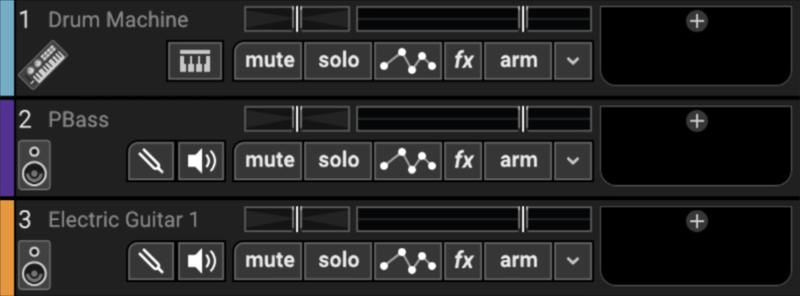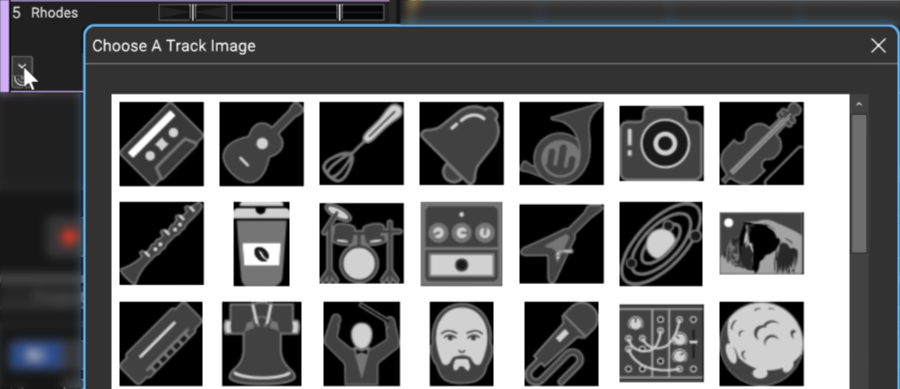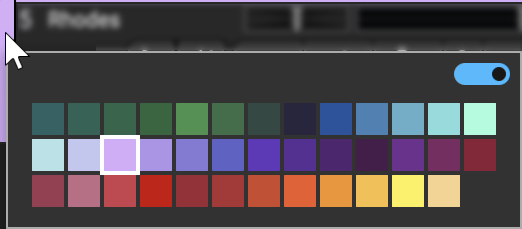TRACKS AND TYPES

The Track List is found at the left side of Mixcraft’s main interface window. Each track contains controls for volume, panning, muting, soloing, and more. There are a number of track types, each with its own purpose and variations in its controls. You can play or record as many tracks as you like (until your computer starts billowing smoke). The exception is that a project can only have one Video and one Master track. First, we’ll go over some common controls for most track types, then get into specifics for each track type.
The table below shows Mixcraft’s various track types and their basic functionality, followed by an in-depth explanation of each.
Track Type | Details |
|---|---|
Audio | Record audio or remix loops. |
Instrument | Edit or record MIDI data. |
Video | Add and edit video files or still images. |
Video Text Track | Add and edit video static and scrolling text to videos. |
Master | Shape the master volume and effects - this is where effects are inserted into the main output bus. |
Submix | Nests and combines audio and instrument tracks. |
Send | Share effects between multiple tracks. |
Output | Additional output busses in addition to the Master Track. These are used to route audio to physical outputs with multiple-out audio hardware. |
Rewire | Controls a third-party Rewire application. |
Vocoder | Creates a Submix track with control and instrument tracks preconfigured for Acoustica Vocoder. |
Instrument Mix | Mix additional audio channels from virtual instruments with multiple output busses; this is automatically created when a virtual instrument with multiple output channel is added. |
ADDING/MOVING/SIZING/DELETING TRACKS
Drag, right-click, or use key shortcuts to add, delete, move, and duplicate tracks.
MOVING TRACKS
Tracks can be moved by clicking and dragging them vertically within the Track List.
RESIZING VERTICAL TRACK HEIGHT

To resize a single track vertically, move the mouse to the bottom of a track and drag it up or down. When the mouse is in the correct location for resizing, the cursor will become an up/down cursor.
Height can be adjust for all tracks simultaneously either by selecting Track>Properties>Track Height and choosing a size, or by clicking in the track area and using [CTRL]+Alt+Mouse wheel.
DELETING TRACKS
Click on a track to select it. Then click Track>Delete Track, or right-click on the track and choose Delete Track. All sounds on the track will also be deleted.
CUSTOMIZING TRACK APPEARANCE

Change the color, icon, name, or size of tracks.
NAME

The default name for newly created tracks will be “Audio Track,” for audio tracks, or “Instrument Track,” for MIDI tracks. Tracks can be renamed by clicking the current name and typing. Hit the Enter key or click in another area of the window to finish.
IMAGE

Each track can have its own icon beneath the track name for personalization as well as organization. Choose from Mixcraft’s included images or import your own.
To change the track image, double-click an existing track image or hover over the track image and click the pop-up button. You can also select Track>Properties>Choose Image… in the main window drop-down menus, or right-click on a track and select Properties>Choose Image...
The Choose A Track Image window opens:

To use an existing image, select one and click OK. To use a custom image, click Add My Own Image File..., navigate to the image to be added, select the desired image, and click Open. The image replaces the existing track image and is added to the list of thumbnail images.
JPG, BMP, PNG, and GIF formats are supported, and custom images are permanently added to the track image library for use in future projects.
TRACK COLOR

Track colors can be individually set by selecting Track>Properties>Track Color in the main window drop-down menus or (more easily) by right-clicking a track and choosing Color. This affects the track’s highlight color and all clips on the track.

ADDITIONAL RIGHT-CLICK FUNCTIONS
We apologize for sticking these all the way at the end, but here are some convenient things you can do by right-clicking the track header.
MIX TO NEW AUDIO TRACK
Mixes all Virtual Instrument or audio clips on the selected track to a single, continuous audio clip and places it on a newly created track beneath the current track. This has a couple of practical uses:
• Convert MIDI Virtual Instrument To An Audio Wave
This is useful if you’re handing off files to some chump another user who doesn’t have virtual instruments you’ve used in a project.
• Permanently Embed Insert Effects Or Instruments In An Audio File Again
This is useful if you’re handing off a project to another user who doesn’t have effects plug-ins you’ve used.
• Long-Term Archiving
Instrument or effects plug-ins can become obsolete or incompatible with current operating systems/format changes, etc. Converting to “pure” audio files can act as insurance to guarantee projects remain playable for years to come.
DUPLICATE
Creates a copy of the track and all of its clips. This is a time-saver if you want to add a second part using the same instrument, add a vocal double with the same plug-
in setup, etc. Also useful if you’d like to try some wild edits and want to retain an unadulterated version.
FREEZE

Freeze is similar to Mix To New Audio Track; it creates a new audio file with instruments or effects “burned in” to the file. Unlike Mix To New Audio Track, it does not make a new track; the audio is created in the background and plays back on the existing track. Because instruments and effects are part of the newly created audio file, Mixcraft disables instrument and effects plugs upon playback, thus freeing up computer processor resources. If you’re using an older or underpowered computer, Freeze can be tremendously helpful (check out the CPU percentage meter while playing back projects for reference). Conversely, if you’re using a fast, modern computer, you probably won’t need Freeze.
As shown above, frozen tracks turn blue with diagonal lines; this makes it easy to keep track of which tracks are frozen.
Frozen tracks can be unfrozen, that is, converted back to standard tracks with instrument and plug-ins active, by reselecting the Freeze command (which will say Unfreeze).